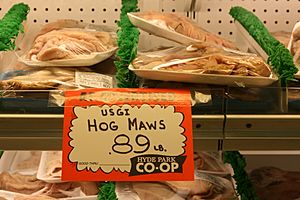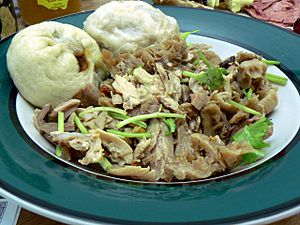Hog maw facts for kids
Hog maw is the stomach of a pig. It's the outer muscle part of the stomach, cleaned so it has no fat. People eat hog maw in many countries. You can find it in American, Chinese, Pennsylvania Dutch, Mexican, Portuguese, and Italian dishes. It can be cooked in different ways, like stewed, fried, baked, or broiled.
Contents
Hog Maw in Different Cuisines
Pennsylvania Dutch Cuisine
In Pennsylvania Dutch cooking, hog maw is a special dish. People sometimes call it "pig's stomach," "Susquehanna turkey," or "Pennsylvania Dutch goose." In the Pennsylvania German language, it's known as "Seimaage." This name comes from the German word "Saumagen."
Hog maw is made from a cleaned pig's stomach. It's usually stuffed with cubed potatoes and loose pork sausage. Sometimes, other ingredients like cabbage, onions, and spices are added.
Traditionally, it was boiled in a large pot. It's a bit like Scottish haggis. But it can also be baked or broiled until it turns golden brown. People often drizzle butter on it before serving. It's usually served hot, cut into slices, with horseradish or stewed tomatoes. You can also eat it cold in a sandwich. This dish was often made in winter, especially on days when farmers butchered hogs in places like Lancaster and Berks Counties.
Many Pennsylvania German families eat hog maw as a traditional side dish on New Year's Day. Some families believe it brings good luck to eat even a small piece on New Year's Day. This is similar to the tradition of eating pork and sauerkraut. You can buy the cleaned pig stomach from traditional butchers at local farmers' markets. The original recipe likely came to Pennsylvania from the Palatinate area of Germany. There, it's called Saumagen and is served with sauerkraut.
Soul Food Cuisine
Hog maw is also a dish in soul food cooking. It is often eaten with chitterlings, which are pig intestines. In a cookbook called Plantation Row Slave Cabin Cooking: The Roots of Soul Food, there is a recipe for Hog Maw Salad.
Like in Pennsylvania Dutch tradition, hog maw is also prepared for New Year's Day in Southern cooking. People eat it for good luck and prosperity. Other traditional Southern New Year's Day dishes include collard greens and Hoppin' John.
Chinese Cuisine
In Chinese cuisine, hog maw is called 猪肚 (zhūdǔ). This means "pig stomach." It is often stir-fried with vegetables. It can also be braised, chilled, and sliced. These slices are then served as part of a cold dish.
Latin American Cuisine
In Mexico, hog maws are called "buche." They are a popular food at taco stands. They are usually deep-fried with other parts of the pork.
In Puerto Rico, hog maws are called Cuajos. A dish called Cuajitos is a popular street food found all over the island. It is often served with boiled green banana escabeche and morcilla (blood sausage).
See also
 In Spanish: Estómago de cerdo para niños
In Spanish: Estómago de cerdo para niños



